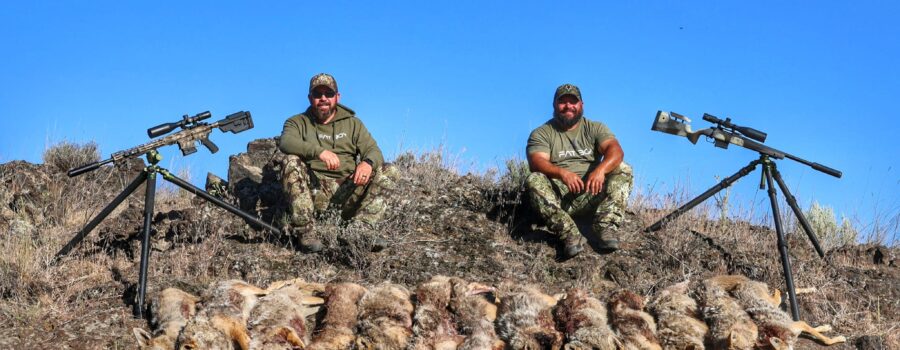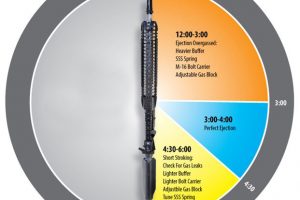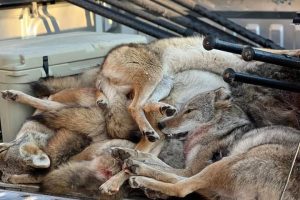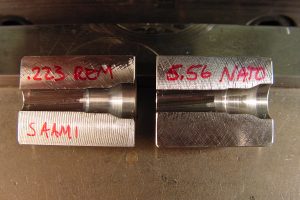Hitting AND killing every coyote that you shoot at. It’s that simple, and it’s no secret. This is the number one way to increase your end year totals. While simple, it’s also what a lot of coyote hunters fail to do on a consistent basis. I’ll admit. I miss coyotes from time to time, and I have posted the videos that show that. But if you want to increase your yote numbers, you need to kill every coyote that comes within your shooting range. Simple.

Rich Gonzales and Nick Nabor
Do you want to step up your game? Do you know what separates a lot of the top tournament hunting teams from the rest of the pack? They can flat out shoot! They rarely miss. They know their equipment and DOPE. They kill most every coyote that comes into the call. Generally, these teams also have a guy or two that is very proficient at long range shooting. I know of some teams that have guys that can consistently kill coyotes at 600 and 700yds. Even at night.

Rich Gonzales long balling it with his 6 Creedmoor. Green dot on the horizon was where the shot was taken from.
I know that I’ve had stands where pressured coyotes, or “educated” coyotes have come to within 500 or so yards, and then they won’t commit any closer. Maybe you’ve experienced this, too? Two weeks ago, I was hunting with a buddy and we had six coyotes hanging up at about 600yds. This was after we closed the gap by 200 or so yards. But we couldn’t move any closer through the open field towards the wood line they were on. Neither one of us were shooting a cartridge that was sufficient for making a clean shot at this distance. Even if I was, that distance is a little more than what I am proficient at.
Invest in You
So, what goes into killing more coyotes? Proficiency and practice! Mainly anyway. There is something to be said for quality equipment, but that’s a rabbit hole that we won’t go down here. We may skirt the edge of it, though.
I’m not going to get into a caliber debate, but I will leave you with the following. Choose the proper ammunition and/or bullet for the cartridge that you are shooting. The bullet needs to have enough velocity to perform as it’s designed at the impact distance that you’re shooting at. Bullet design is also critical to its terminal performance. For the most part there are two camps here. The bullet goes in, but doesn’t exit. It dumps all of its energy inside of the animal. The other is more common of the typical expanding style bullets. The bullet goes in and exits. It’s relying upon expansion for the temporary and permanent wound channels, combined with loss of blood. When this occurs, the bullet is not dumping all of its energy into the target. It has retained energy, as it has passed through the target. You also want to make sure that you’re shooting a bullet that is appropriate for coyote sized animals. Meaning that for the most part, you don’t want to be shooting a bullet that’s designed for medium game, or even larger. This will lead to pass through shots that generally will pin hole or ice pick both sides of the yote. Generally this does not equal a DRT result. Dead Right There. This is the result that I, and most coyote hunters want. Especially tournament hunters. The more time that you have to spend looking for a coyote that ran after you shot it, the less stands that you will be able to make. If you want to kill a lot of coyotes, you need to make a lot of stands. One last thing on this. Some cartridges allow for more of a fudge factor on shot placement. Most all cartridges will work for coyote hunting, but there are options that greatly increase your lethality on coyotes.

6 ARC 58g V-Max Entry- No Exit

6 Creedmoor Exit
Practice. Practice. Practice! And get off of the bench. This is where I see many coyote hunters fail. They don’t’shoot or practice all year long. I see it all of the time at the main range that I go to. Just last week I was at the range on a few different occasions and each time I saw guys struggling to get their thermal sighted in. Some were having gun issues. A couple of guys were trying to diagnose why they weren’t hitting their POA and were blaming the optic. Maybe. But doubtful. In talking with these individuals, they were all getting ready for coyote hunting. Mind you, here in Iowa we can hunt year around. Most will look at it as October or November through around March. Yet the majority of them said that the rifle had been sitting since last season. Some hadn’t even been cleaned or lubricated.
Shoot year around. I know things get busy, but make it a point to get out at least a couple times a month. Get off of the bench if your range will allow for it. It’s fine to shoot from the bench to work on your fundamentals, but shooting from the tripod will verify those, as well as force you to work on other skills.
One of my preferred drills for being consistent on a rifle is the dot drill. This drill can be done a couple of different ways, but I typically use it for getting on the gun in a consistent manner. Take a backer of some sort and put a few rows of 1”, or whatever size you prefer, dots on it. Set it up at 100yds. I do this from the bench as well as the tripod. With a zeroed rifle, position the rifle on bags. On the first dot, get yourself settled, proper sight picture, etc., and execute a shot. It should be in the dot. Get up from the bench now. Maybe walk a short bit. Get back into position and repeat the process. Get settled. Proper sight picture. Etc. Execute the shot. It too should be in the dot. Repeat this for each dot. You’re looking for consistency in POI from dot to dot. As the barrel warms, it may start to walk, but you can take this into account. If you’re all over from dot to dot, then you have something going on in your fundamentals. You’re not consistent on the gun. The process is the same from the tripod, except that you’ll step away from the tripod between shots. You can also stay on the gun between dots and shoot it more as a precision type drill. Testing your natural point of aim, trigger pull, follow through, etc.

Dot Drill Target Example
If you or your range has steel, set up some steel targets at different distances. Shoot them from the tripod if possible. Are you shooting with a buddy? Have your buddy call out a specific target. Then you find and engage it. Want to make this more difficult? Add a timer and a Par time. Meaning a set time that you have to put a shot on target. Most, if not all, timers have this function. Once set, the timer will beep giving you your go signal. At the time that you preset, the timer will beep again signaling that your time is over. You can even run a Par time to a single target when you’re shooting by yourself. The video below is me running the 6 ARC with 80g VT ammunition on a 4″x4″ plate and 8″ plate at 220yds.
You say that you’re limited to 100yds and don’t have any steel or fancy targets? That’s OK! You can work on shooting groups. Your fundamentals. You can put targets of different sizes and shapes up at 100yds. This will add a varying amount of difficulty. You can even run a Par time if you wanted to. There some free timers in the app stores that may work OK if you don’t have a timer.
Whatever you do, make your shooting count! Don’t just go and make expensive noise.
It’s always a good idea to check your zero from time to time. I can’t recall how many times I’ve heard somebody say “I don’t remember where my zero is. Guess I’ll find out.” If you zero off of a bench, always verify it from the tripod. Sometimes the POI may shift between the two. I recently experienced this myself. Usually my POI’s are the same. Not this time.
Speaking of zeroing. When you zero your optic, make sure that all attachments are in place. More specifically, if you use a suppressor make sure that it’s on. Generally speaking, adding or removing a suppressor will change your POI. Sometimes by a great amount. The other day when I was at the range a guy was zeroing his thermal. He had made the comment to me that he had forgot his suppressor, but he wanted to get zeroed. OK. Good luck with that. I tried to talk to him about it, but it went nowhere.
If you clean your rifle barrel, foul it before you decide to take it hunting. It’s not uncommon for a clean barrel to have a different POI from a dirty barrel. One that has carbon and copper in it. I generally will put about 10 rounds through a clean barrel before I will hunt with it.
On Stand
The following may create some criticism and arguments. Generally, I won’t shoot at runners. For one, I’m not very good at it. Probably because I don’t do it enough to get good at it. I have dumped a few on the run, but I’ve missed many more and wasted a lot of ammo. Guys that I know that kill a lot of coyotes, generally won’t shoot at runners either. Tournament or out of state hunting is a bit different. In these cases, the majority of the time, one is not worried about going back and hunting that spot any time soon. If ever again.
What I’ve come to find is that a lot of the time a runner may stop and provide you with another shot opportunity. The same applies when multiple yotes come in. After the first one is dumped, the others begin to scatter. It’s not uncommon for some of them to stop and offer shot opportunities if they haven’t been mag dumped on and have it in high gear headed for the next county. If the belly of the coyote isn’t dragging the ground in an ultra low high speed drag reducing posture, or the ears are not pinned back, there’s a chance that the coyote may stop again. This is where your call can come in handy, too. Sometimes a quick hit of a preset that is a howl or coyote distress may distract that coyote from its thought long enough that it’ll stop and provide a shot opportunity.
I don’t mind leaving a couple to run off on a stand. I’ll go back after them at another time. I do believe that like a domesticated K9, that a coyote will associate things as positive or negative as it relates to things in their environmental area, and that they tie this to experiences. Like how we train dogs. Take a dog with an underground fence for example. It may take a few zaps from the collar, but at some point most dogs will know that hey I can go to this point. Beyond that, I’m going to get a pain in my neck. A good example of this is this past winter. I pulled into a field edge to hunt a field. Scanning the field I see a coyote already out there mousing around. I get the rifle set up and I drop the call a few feet from me. This coyote was about 200yds from me. I turned on a rabbit distress at a low volume. He immediately turned and ran back to the woods that he came from. Gee. Do you think he’s heard that sound before and had a negative interaction? Lol. I did call that yote back out with some pup distress.
Gear- Kind Of
I said that I wasn’t going to make this about gear, and I’m not. But there are a couple of things that need to be mentioned if you want to increase the number of coyotes that you kill.
Make sure your rifle works 100% and that it shoots consistent groups. Know the limitations of your rifle and other shooting related equipment. Be realistic about this. Certain cartridges may not provide the needed terminal ballistics at 200 or 300yds or further. If your rifle is an MOA rifle, that’s ok. Just know that you may be limited with some shots. Can you make that headshot at 150yds as that’s all that you can see of the yote? Can you take that quartering away shot at 100yds. It’s a small vital zone and there’s a good chance of a gut hit. I think you get the idea. If you or your rifle is larger than an MOA shooter, than this has to be taken into consideration. Can you make that shot at 200 or 300yds? A practical example. The vital area of an average adult coyote is roughly 6” to 8” in diameter. If you’re shooting say 1.5 MOA, that’s 3” at 200yds. That’s half or about half of the vital area. Further out you go, it doesn’t get any smaller and environmental conditions may not always be perfect for you to shoot your average.



Consistency. I’ve used that word a bit. Where it really comes into its element is in your shooting platform. A solid and robust tripod will greatly aid you in making precise shots, shots at longer distances, as well as mitigating recoil and staying in the optic. It can also decrease the time spent making the shot. AKA shot timing. Like cartridges, tripods are a hotly contested and debated topic. Here’s what I will say. Tripods are money well spent. Yes, a decent amount of money. Get rid of the center column tripod. Get rid of the flimsy tripod that has the legs flexing and bowing when you load it. Make the move to an ARCA mount. While some tripods have 3rd party 3D printed or manufactured ball heads, just skip these and get a quality tripod and ball head. It will provide more stability and a smoother operation. I can’t tell you how many times I’ve had somebody get behind one of my rifles on one of my tripods and they’re blown away by how stable and solid it is in comparison to theirs. It is money well spent if you want to increase your odds of killing more coyotes.





